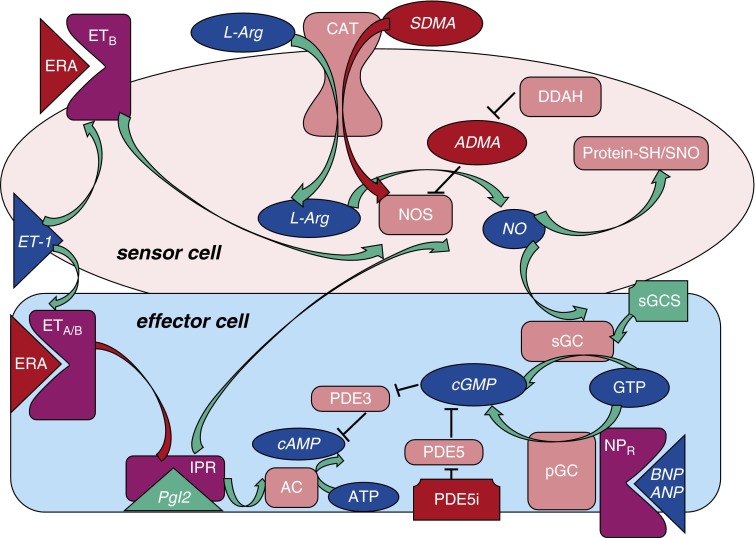Figure 1.
Vasoregulatory mediators and/or biomarkers relevant to current pulmonary arterial hypertension (PAH) therapy, and their interactions. Endogenous mediators (blue ovals), enzymes or other protein targets (both shown as pink rectangles), mediator-relevant drugs (green [stimulatory] or red [inhibitory]), and PAH-associated derangements are interconnected (also red). Mediators produced by a sensor cell may influence an adjacent or distant effector cell. Classically, this involves signaling by endothelial cells (ECs; “sensor cells”) to influence “effector cells” (e.g., vascular smooth muscle cells [SMCs]), but, in PAH, many cell types are involved. Relevant mediators may act in an autocrine fashion also. The vasoconstrictor and mitogenic peptide, endothelin (ET)-1, acting at ETA or ETB receptors, is antagonized by ET-1 receptor antagonists (ERA). ECs also produce nitric oxide (NO) from the precursor amino acid, L-arginine (L-Arg); asymmetric dimethyl arginine (ADMA) and symmetric dimethyl arginine (SDMA) (red) may antagonize this. Levels of ADMA depend, in part, on its catabolism by dimethylarginine dimethylaminohydrolase (DDAH). Antiproliferative and pulmonary vasodilator actions of NO produced by lung ECs can be mediated by the activation of soluble guanylate cyclase (sGC) in, for example, vascular SMCs, or by more durable S-nitroso (SNO) modification (S-nitrosylation) of regulatory thiols (SH) on key proteins. Cyclic guanosine monophosphate (cGMP) formation from GTP is the result when sGC is stimulated by NO. Notably, brain natriuretic peptide (BNP; or atrial natriuretic peptide [ANP]) can also elicit the formation of cGMP from GTP via a membrane-bound GC enzyme (particulate GC), possibly contributing to the (paradoxically) elevated cGMP levels typical of advanced PAH. Other mediator interactions include prostacyclin receptor- and endothelin receptor (ETR)-triggered NO synthesis, and cyclic adenosine monophosphate (cAMP)/cGMP cross-talk via phosphodiesterases (PDEs). For example, PDE3 can catabolize either, while PDE5 is selective for cGMP. Mediators that are also potential or proven biomarkers are in italics. AC, adenylate cyclase; CAT, cationic amino acid transporter; IPR, prostacyclin receptor; NOS, nitric oxide synthase; NPR, natriuretic peptide receptor; pGC, particulate guanylate cyclase; Pgl2, prostacyclin.

